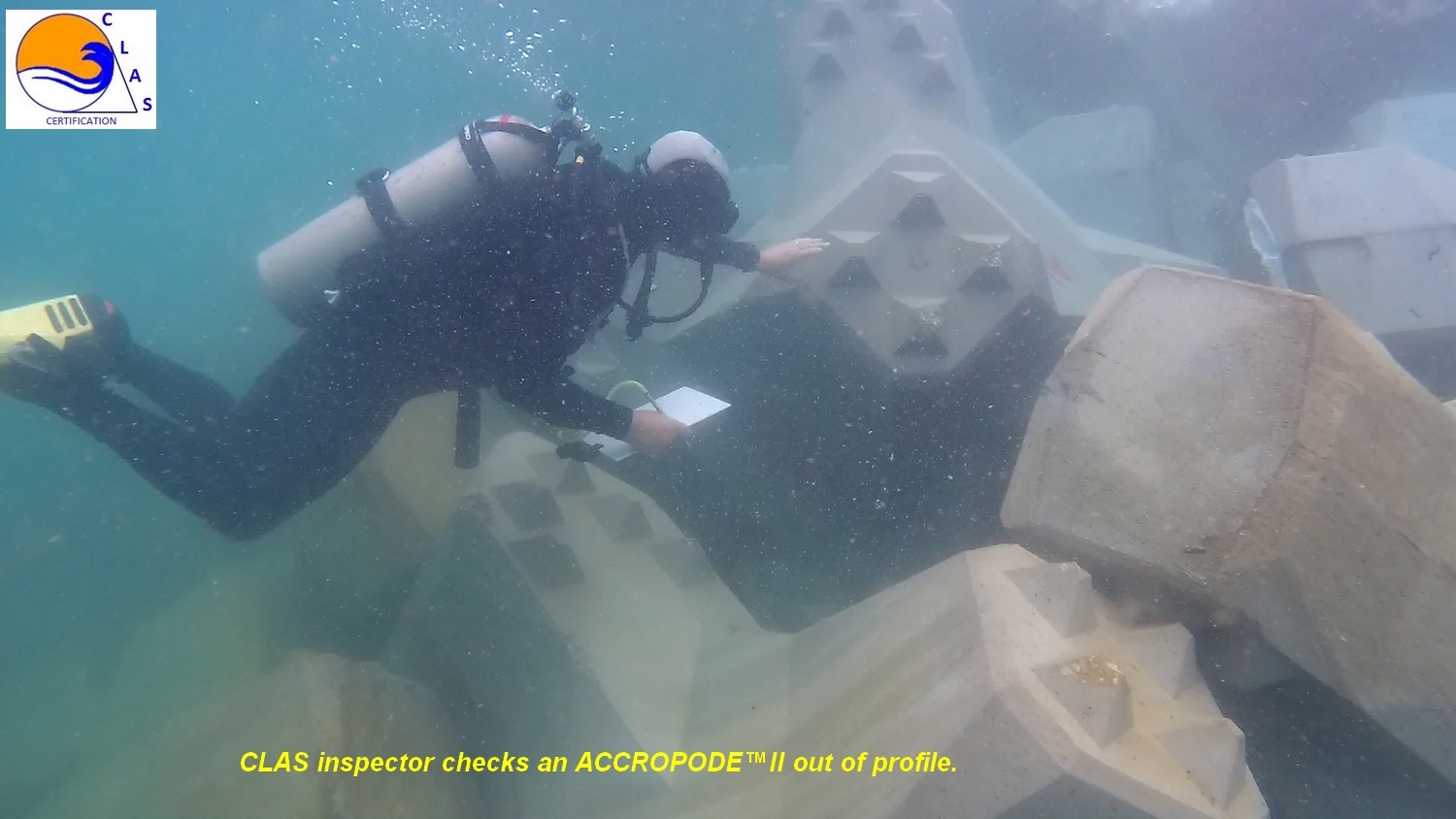ARTIFICIAL UNDERLAYER
FOR THE CONSTRUCTION OF BREAKWATER ARMOURS
INTRODUCTION
Experience has shown us that the major problem faced by contractors in the construction of ONElayer armored breakwaters is the construction of the underlayer. It consists of a sub-layer made up of two layers of stone, which must meet strict tolerances, otherwise single-layer armor technologies cannot be implemented normally. This makes placing the artificial blocks difficult, if not impossible. Non-compliance with these tolerances calls into question the very stability of these armour.
ACCROPODE™II out of profile and poorly nested due to an underlayer defect

During the construction phase, it is not uncommon to see the swell destroy this underlayer. This causes a significant financial loss, delays construction and in fact penalizes companies heavily.
ACCROPODE ™ II covered by the underlay materials and core after a storm Xbloc covered by the underlayer materials


This happens on almost all construction sites to the point that CLI illustrated it in its DIT a short time ago:

Another recurring problem is the supply and price of rockfill that meets the requirements for the construction of breakwaters.
The problems that the production of this rockfill poses for the environment are more and more often taken into consideration by project owners, particularly with regard to the carbon footprint.
Destruction of mountains

Nuisances caused by transport

PRESENTATION DE LA SOUS-COUCHE ARTIFICIELLE
Il existe aujourd’hui des techniques de protection de pipelines immergés et de berges de fleuves, mettant en œuvre des panneaux de plots béton reliés entre eux, jointifs ou espacés.

Ces technologies sont modifiables et applicables à la protection du noyau d’une digue. Les panneaux adaptés à la pose de blocs de carapace monocouche reproduisent la rugosité demandée et restent dans les tolérances, de manière maitrisée par conception et par construction.

Two layers of concrete pads are necessary to promote the flow of water. The first uses blocks of uniform size, linked together by a loop geotextile or by cable if the core is not to be insulated with a geotextile (protection strongly recommended). The second implements studs of different thicknesses, which reproduce the roughness of the natural underlayer. In the case of the possible implementation of a single layer, this layer will reproduce the roughness of the natural sub-layer.
Manufacture of layers of contiguous plots on geoteclie with loops.
This is the technology that was used to build the anti-scour mats that protect the piers of the Nouvelle Route du Littoral viaduct in Reunion:

The second layer uses the same molds but their filling is not uniform and the studs can be connected by cable, so as not to limit the flow of water between the two layers of concrete studs.
THE IMPLEMENTATION OF THE ARTIFICIAL UNDERLAYER
The implementation of the panels which constitute the underlayer, takes up the existing know-how for laying the protections of pipelines and banks:

The installation and adjustment of the panels between them must be supervised by inspectors accredited by CLAS, who have the professional capacity to intervene in diving.
In addition to environmental protection and in some cases the price, this technology has the following advantages:
Speed of core protection,
Greater stability in the face of the swell than an unconnected natural rockfill sub-layer,
No more risk of being out of tolerance.
The artificial underlayer is designed for all types of single-layer artificial blocks: ACCROPODE™, ACCROPODE™II, ECOPODE™, CORELOC™, X-bloc ®, BS1, BS2 and BS3.
The CLAS company calculates for you the size of the concrete blocks to be used, establishes the best installation solutions and supports you in the implementation and certification of the quality of the work.
This innovative concept has been the subject of a European patent, registered under the number:

The exploitation rights of this patent are now contractually shared between CLAS SLU and Mr. Albert KOFFLER, recognized co-inventor.
Since the creation of IDMer, now CLAS, we have been looking for technical solutions that solve the problems encountered by companies in the construction of sea dikes. We have developed recognized know-how in the field of personnel training, safety and speed of construction. We have created the concept of artificial underlay, we are developing an economical and ecological technique of toe stop. We are experimenting with a system intended to reduce the turbidity of the water caused by the construction of the structure, which hinders or stops the inspection and block-laying operations in certain cases. We are not passive in front of the problems encountered by companies, we implement solutions.


